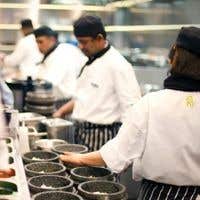This article was also published in the Financial Times.
71 High Holborn is a large, bright corner site close to London's four Inns of Court that in two different incarnations has provided contrasting insights into how restaurants are enjoyed.
The first was several years ago when it was Matsuri, a Japanese restaurant where I shared a meal with the late Anita Roddick, the ebullient founder of The Body Shop, who had bid to have lunch with me as part of a charity auction. When the dessert menu came, Roddick immediately chose the mango sorbet, explaining that 'our mango body butter has always been our best selling item and naturally I've always had a great affinity for mangos as a result'.
More recently, I ate there for the fourth time, but on this occasion with Dong Hyun Kim, who has transformed this into Kimchee, a bustling Korean restaurant. One day he may well have the same impact on our High Streets as Roddick.
Kim, 41, is a quiet, passionate and obviously very determined restaurateur who seemed, as we bowed and shook hands at the end of the first interview he has ever given, to have quite enjoyed the experience.
He currently employs 1,200 across 35 Wasabi cafes and takeaways in London, with a branch opening in New York's Times Square in June and others planned for France and Dubai, plus the current Kimchee with more of these to follow. 'By 2015 I plan to have 50 Wasabis and 15 Kimchees', he added with conviction.
The genesis of all this, I learnt, has been his ability to create two equally memorable and resonant brand names, Wasabi and Kimchee, aligned, somewhat more mundanely, to four years working on the stalls of London's Camden Town market.
That was 14 years ago when a job took Kim to Camden. He soon had the opportunity to run several stalls himself that he promptly turned over to cooking takeaway Asian food and it was this experience of working so close to his customers that provided two invaluable lessons. 'First of all, I learnt that people eat with their eyes. Food has to look as colourful and presentable as possible, regardless of how inexpensive it is. The second was that talking to my customers, I could see that they were growing increasingly fascinated by sushi.'
A stint in Tokyo after a finance degree in his native Seoul gave Kim the confidence to open the first Wasabi in 2003 by Embankment underground station in London. Innovatively, he allowed customers to buy takeaway sushi by the individual piece. 'Until then, it was only available in a pre-packed box that might include several pieces a customer wouldn't necessarily choose. I wanted to let my customers eat whatever they wanted so that sushi would become part of their life', Kim added. Increased efficiency has led to prices that are still inexpensive – two pieces of tuna nigiri are £1.70, the same of crab and avocado hosomaki £1.50. A wide customer base that on the day I ate there included office and construction workers, students, legal secretaries and several working in the nearby headquarters of Sainsbury's supermarkets.
Having opened four branches of Wasabi, Kim turned to Kimchee and his native Korean food. He decided that the only way in which he could successfully create his vision was to become a chef himself so he opened his first, small Kimchee, now closed, in the north London suburb Golders Green, and hired a Korean chef from whom he could learn. His working day began in the mornings overseeing Wasabi's expansion before he would leave to put on his chef's whites in the afternoon and evening.
The combination of his own growing culinary confidence plus the cash flow from Wasabi put Kim in a position where, as he described it, he was 'ready to go' with Kimchee on a much bigger scale. But the situation called for Kim to take on another role. He realised that he was trying to educate Londoners about a style of cooking that they were not yet completely comfortable with so he decided to project manage the building's transformation himself. 'I could not tell the builders or my staff what to do if I wasn't completely confident of the outcome', he explained.
The result is a combination of certain aspects of distinct Korean culture, such as the water feature by the front door, cases of Korean antiques along the long open kitchen, an attractive paper placemat on the tables, and a modern layout that is softened by well chosen lighting, all of which combine to make the space fun and enticing. And, remembering the lessons he learnt on the market, the crockery on which the food is served is bright and colourful, a long way from the standard white.
This does not detract from the spiciness of some of the dishes, although none is quite as hot as those I endured in Seoul. Among the dishes we enjoyed were the chicken and vegetable dumplings; the lemon sole, mackerel, asparagus and rib eye from the charcoal grill; galbitang, a slow-cooked soup made from short ribs; and their various bibimbaps, the traditional Korean combination of rice, vegetables, with chicken, beef or seafood cooked in an earthenware pot. All, of course, with a small amount of kimchee, the spicy, pickled cabbage condiment.
Now that Kimchee is serving over 800 a day with an average spend of under £20, Kim seems happy, the memories of its difficult initial three months' trading almost forgotten. Backing another restaurant hunch has successfully paid off.
Kimchee 71 High Holborn, London WC1V 6EA; tel 020 7430 0956 www.kimchee.uk.com

